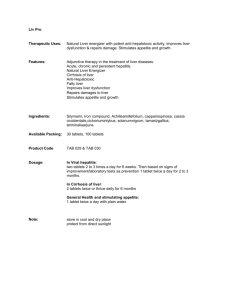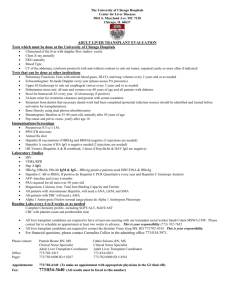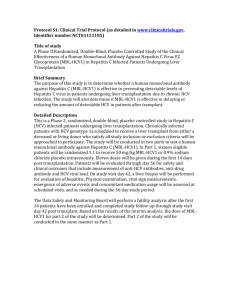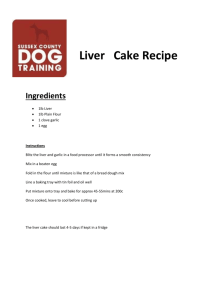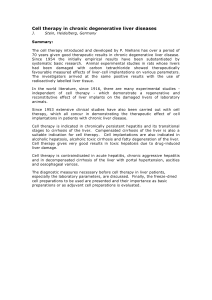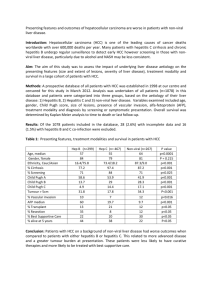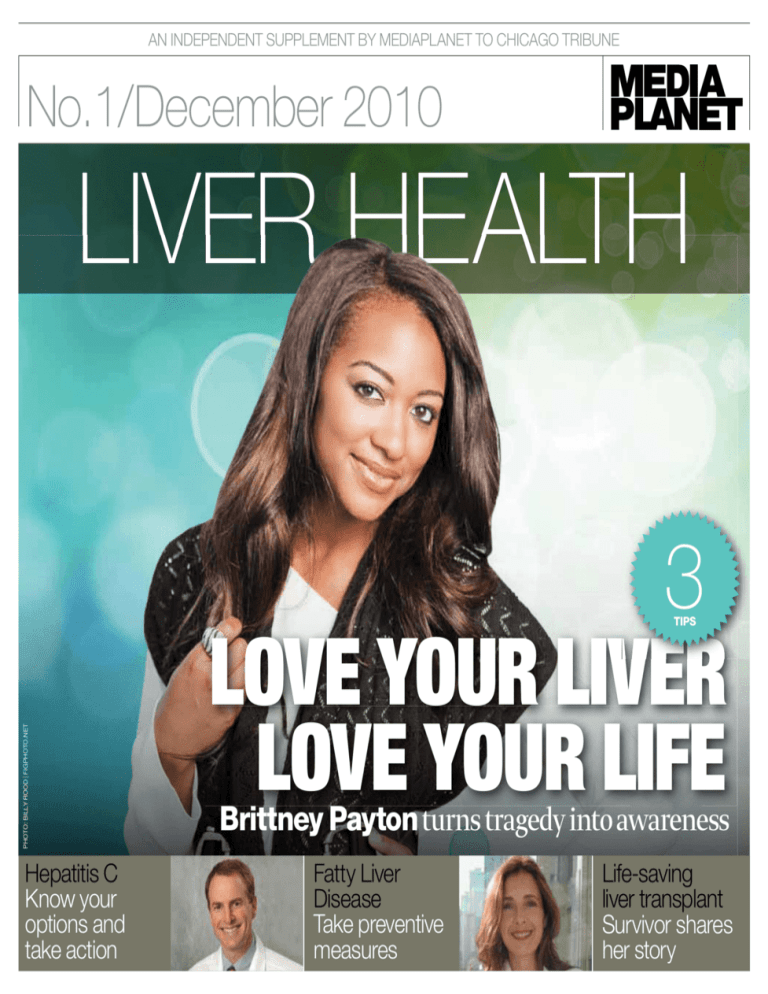
AN iNDepeNDeNT SUppLeMeNT by MeDiApLANeT TO CHiCAgO TribUNe
No.1/December 2010
liver health
3
Love your Liver
Love your Life
Photo: Billy Rood | figPhoto.net
tiPs
Hepatitis C
Know your
options and
take action
Brittney Payton turns tragedy into awareness
Fatty Liver
Disease
Take preventive
measures
Life-saving
liver transplant
Survivor shares
her story
2 · DeCeMber 2010
AN iNDepeNDeNT SUppLeMeNT by MeDiApLANeT TO CHiCAgO TribUNe
challeNges
Liver disease does not discriminate.
It can strike children, people in their prime family
and career building years, and the elderly.
We Recommend
Assemblywoman
Fiona Ma
explains what one
city is doing to control
an epidemic.
pAge 4
A dynamic virus
p. 5
Becoming a donor
p. 8
Hepatitis C : What are your options?
healthy liver for a lifetime
O
ften people
have
little
understanding
of what functions the liver
performs to
keep the body
healthy or steps to take to achieve
liver wellness.The fact is,the liver is a
vital organ,and a person simply cannot live without it.The liver helps the
body digest food,store energy,manufacture proteins and remove poisons
from air,exhaust,smoke and chemicals that a person may breathe.
Keep your liver healthy
One way to ensure that your liver
stays healthy and strong is to keep
a healthy lifestyle. The no-brainer
here is to eat a well balanced diet and
maintain a healthy weight.The liver
makes the cholesterol your body
needs, but too many high calorie
foods can cause fatty liver disease,
one of the fastest growing condi-
tions, leading to severe liver disease.
Another area to focus attention is
alcohol intake.Using alcohol responsibly is key to maintaining a healthy
liver.It is known that too many alcoholic beverages can create many
health problems, including scarring
of your liver. Additionally, over-thecounter medications can affect the
liver as well. Everyone needs to read
labels carefully to ensure they are
not abusing medication that can
have dire consequences for the liver.
Vaccinations and screening
One way to ensure a healthy liver is
to go out and get screened for some
of the more common liver diseases.
While there are now vaccinations
for hepatitis A and B, hepatitis C still
has no vaccination.Prevention is key,
but to ensure you do not have hepatitis, screening is a necessity. If you
have risk factors such as intravenous
drug use, blood transfusion prior to
1992, shared razors, needles or tooth-
4
health
tiPs
Be careful with aerosol sprays. Your liver has
to detoxify what you breathe in.
So when you use aerosols, make
sure the room is ventilated or
wear a mask.
Wash your hands. Several types of liver disease
are spread through contact with
contaminated water or other
items. Washing your hands is a
valuable defense to avoid these
diseases.
Practice safe sex.
Unprotected sex or sex with
multiple partners increases your
risk of hepatitis B and C.
Learn more about liver
disease. Go to www.liverfoundation.org for more information on liver disease and ways
you can keep your liver healthy.
1
2
3
4
brushes or have had unprotected
sex than it is very important to be
tested. Simple blood tests can determine many types of liver disease.Ask
your physician for a complete liver
analysis.
The American Liver Foundation
(ALF) is the nation’s leading nonprofit organization promoting liver
health and disease prevention. ALF
provides research, education and
advocacy for those affected by liverrelated diseases, including hepatitis.
ALF has many events throughout
the year that need people like you
to help with fundraising and educational programs. Get involved today!
Call ALF to volunteer! Make a donation.Help make a difference.
For more information about liver disease
or the American Liver Foundation, go to
www.liverfoundation.org or call 1-800-GOLIVER.(800-465-4837).
the american liver foundation
editorial@mediaplanet.com
emma brown gives thanks
to organ donors.
liveR health
1st edition, decemBeR 2010
Managing Director:
geraldine delacuesta
geraldine.delacuesta@mediaplanet.com
Editorial Manager: Jackie mcdermott
jackie.mcdermott@mediaplanet.com
Responsible for this issue:
Publisher: Paul stover
paul.stover@mediaplanet.com
Business Developer: lee auerbach
lee.auerbach@mediaplanet.com
Designer: missy Kayko
missy.kayko@mediaplanet.com
Contributors: american liver
foundation, dr. Joseph ahn, emma
Brown, dr. scott cotler, dr. donald
Jensen, fiona ma, Brittney Payton, tim
Radway, dr. nancy Reau, dr. mary Rinella,
martha saly
Distributed within:
chicago tribune, december 2010
this section was created by mediaplanet
and did not involve the chicago tribune or
its editorial departments.
Mediaplanet’s business is to create new
customers for our advertisers by providing
readers with high-quality editorial content
that motivates them to act.
Liver Health
A topic inspired by
Sherri Wilson
A legacy of understanding.
A vision of discovery.
Merck is committed to building on its strong legacy
in the hepatitis field by continuing to discover,
develop, and deliver therapies that treat viral hepatitis.
Extensive research efforts are underway to develop
compounds that help advance hepatitis care.
Copyright © 2010 Schering Corp., a subsidiary of Merck & Co., Inc.
All rights reserved. PGN1227 12/10
4 · DeCeMber 2010
AN iNDepeNDeNT SUppLeMeNT by MeDiApLANeT TO CHiCAgO TribUNe
News
Prevent hepatitis B
hepatitis B awareness in asian-americans
hePatitis B PRevention
is key in prevention
Approximately 1.4 million
Americans are infected
with hepatitis B. More than
half of the 1.4 million Americans infected are Asian/
Pacific islander Americans—i am one of them.
I contracted the disease from
my mother via perinatal exposure which is a common way
hepatitis B is transmitted. I
am perfectly healthy and fine
today, but hepatitis B is something that should be monitored
closely because the disease
rarely shows symptoms until it
is too late for treatment. This is
why I feel it is extremely important for people to get screened
and vaccinated.
Chronic hepatitis B is the
leading cause of liver cancer
and liver transplants. Individuals chronically infected with
hepatitis B are at a higher risk
of developing cirrhosis of the
liver or liver cancer. Hepatitis
B-related liver cancer is the
leading cause of cancer death
among Asian/Pacific Islander
men.
Talking about issues like hepatitis B isn’t particularly “sexy,”
but hepatitis B is becoming
more and more of a problem
within the Asian-American
community and we need to do
more about it. We need to bring
the discussion to the forefront
and make sure everything that
can be done to promote awareness and prevention of hepati-
Fiona Ma
honorary chairperson sf
hep B free campaign
tis B is done.
A lack of awareness coupled
with cultural differences and
language barriers prevent many
Asian-Americans from getting
screened and seeking medical
attention. Many people who
contract hepatitis B will never
develop symptoms, but can still
transmit the disease to others.
For the last two years, I’ve
worked in San Francisco to
make people aware of the
impact of hepatitis B in California’s diverse communities.
Through the Hep B Free campaign (www.sfhepbfree.org),
we’ve tested thousands of San
Franciscans, provided vaccination and treatment information, and formed a network of
groups committed to ending
hepatitis B.
I hope you will join me and
other organizations in supporting hepatitis B awareness and
prevention. It is important that
we all do our part to bring hepatitis B to the forefront, and normalize the discussion of this
deadly and silent disease.
Hepatitis B is a serious
infection of the liver
caused by the hepatitis
B virus (HBV.)
Up to 25 percent of those affected
with HBV die prematurely due
to cirrhosis and liver cancer.
HBV poses a significant global
challenge with up to 400 million
people infected globally, but also
a national challenge with more
than 1.4 million people infected
in the United States. Up to one
million deaths globally and 5,000
deaths in the United States are
attributed annually to HBV.
HBV is preventable
In the United States, AsianAmericans are disproportionately affected, comprising more
than 50 percent of those with
chronic HBV. Approximately
one in 10 Asian-Americans are
infected with chronic HBV, with
a greater prevalence in those who
are foreign-born. As most AsianAmericans are infected during
birth or childhood, they are more
likely to proceed to chronic HBV
infection, and to delayed diagnosis and treatment. Unfortunately,
although simple diagnostic tests
are available and inexpensive,
most of those affected remain
untested and unaware of their
infection as there are often no
symptoms or signs until it is
Dr. Joseph Ahn
Associate Director, Section of
Heptaology at Loyola University Hospital
“Approximately
one in 10 AsianAmericans are
infected with
chronic HbV,
with a greater
prevalence in
those who are
foreign-born.”
too late. Absent medical education and intervention, this trend
appears unlikely to be altered.
The tragedy of this situation
is that HBV is preventable with
the availability of an effective
and safe vaccine since 1986. Yet,
hepatitis B remains one of the
leading causes of death among
infections which are preventable
with education and vaccination.
Moreover, more than seven FDA
approved medications are available for the treatment of HBV
with excellent safety and efficacy
profiles.
Although the CDC has recommended that Asian-Americans
born abroad and their children
be screened and vaccinated for
hepatitis B, the fact remains
that a significant proportion
of Asian-Americans remains
untested, untreated, and
unvaccinated. One of the most
important limitations in HBV
intervention remains the lack
of awareness regarding HBV
among physicians and members
of the impacted communities.
A growing movement exists in
the United States with national
organizations such as the Asian
Health Foundation, with the support of medical professionals and
hospitals, to spread the word that
HBV in the Asian-American community is prevalent, preventable,
and treatable. Given the great
burden of the disease, this call
to action toward screening, vaccination, and linkage to care to
eradicate HBV is one that we cannot ignore.
Routes of tRansmission foR hePatitis B
Routes of transmission for
Hepatitis B include contact
with infectious blood,
semen, and other body
fluids, primarily through:
■ Birth to an infected mother
■■Sexual contact with an
infected person
■■Sharing of contaminated needles, syringes or other injection
drug equipment
■■Needlesticks or other sharp
instrument injuries.
editorial@mediaplanet.com
AN iNDepeNDeNT SUppLeMeNT by MeDiApLANeT TO CHiCAgO TribUNe
iNsight
1
tiP
Hepatitis C virus (HCV) is a global problem with more than 170
million infected individuals. In the United States, it is the most
common bloodborne infection.Almost four million individuals have
been exposed to HCV and 2.7 million have an active infection..
GEt
sCREENED AND
VACCiNAtED
a dynamic virus
h
CV is a dynamic
virus with an
estimated turnover rate of 2.7
hours, producing more than
12 billion virus
particles a day.The virus sacrifices
accuracy for efficiency, and the
many “mistakes” it makes allow
it to escape both medications
as well as the immune system.
Nonetheless, successful therapy
for hepatitis C permanently eliminates active viral production and
the development of long-term
consequences of disease, such as
cirrhosis,liver cancer,and the need
for liver transplantation.
With significant advances in
understanding the viral characteristics and replication process,
current therapy is effective in
almost 50 percent of candidates
for treatment.
Outlook for 2011
Research has helped to identify
those patients most likely to
respond. For example, patients
that respond rapidly (in the first
month) to treatment are very
likely to achieve a cure and may
even achieve this with less than
the traditional year of therapy.
New genetic testing can identify
patients with improved interferon
sensitivity, helping to identify
those that may respond best to our
currently available medications.
Perhaps most exciting is the
news that HCV therapy is on the
brink of a revolution. We anticipate the FDA approval of two HCV
DeCeMber 2010 · 5
Continuing research for
better outcomes
Dr. Donald
Jensen
Director of Center
for Liver Diseases,
University of
Chicago Medical
Center
Dr. Nancy Reau
Vice president,
board of
Directors,
American Liver
Foundation,
illinois Chapter
protease inhibitors in 2011. These
are the first of many new agents
expected to transform the treatment of HCV. Unlike our current
therapy, these new agents will
predominately be direct-acting
antivirals. These potent medications will actively interfere
with viral production in the liver.
Early investigations suggest that
these drugs, when added to the
backbone of current therapy,
will increase the chance of cure
to about 70 percent in those who
have not received prior therapy,
and are infected with the most
common HCV strain. Of course by
adding these drugs, the potential
for side effects will also increase
and, in addition, individuals who
have failed previous treatment
may respond less vigorously. Furthermore, these medications will
not be a good option for those that
cannot tolerate current treatment,
which remains essential for cure.
The response to this therapy will
also need to be monitored closely.
Viral resistance to this new treatment combination will affect the
effectiveness of future therapies.
Although we eagerly await
these new therapeutic options
in 2011, a second wave of agents
are also in development. Some of
these drugs will target different
aspects of viral replications and
will hopefully result in combinations of medications that will not
only cure more patients but also
shorten and simplify HCV therapy.
Even more exciting, preliminary
studies have shown that combinations of complementary medications (targeting different aspects
of the virus life cycle) suppress the
virus. We can now hopefully envision a future regimen of only oral
medications that will effectively
cure those affected by HCV.
It is important to remember
that although we expect great
improvements to the medications
currently available, many people
respond well to this therapy and
may not be well-served waiting
for these improvements. The success of treatment can be predicted
in addition to determining how
rapidly the virus responds to the
medications. Also, many centers
are enrolling for trials involving
new agents including regiments
of all oral drugs. For more information talk to your doctor to see if
hepatitis C therapy may be appropriate for you. Accurate information can also be obtained through
the American Liver Foundations
(www.liverfoundation.org) and
the American Association for the
Study of Liver Diseases (www.
aasld.org.)
neWs
washington needs to act now
to address hepatitis B and c
Nearly six million
Americans are estimated
to be infected with chronic
hepatitis B or C.
Because our health care system
does a poor job of screening and
testing those most at risk—Baby
Boomers, Asian-Americans, and
African-Americans—most individuals afflicted with viral hepatitis are unaware of their infection
until it is too late. Left unchecked,
hepatitis B and C can lead to far
more serious and expensive medical conditions, including cirrhosis, liver failure, or liver cancer.
The cost of many of these conditions is often borne by Medicare
and Medicaid, which are already
struggling.
An overwhelming majority
of liver cancer cases result from
chronic hepatitis B or C infection.
Liver cancer is the fifth most common cancer worldwide and is one
of the top 10 occurring cancers in
the US, annually striking an estimated 24,000 Americans. If Congress takes action to promote statebased screening and early intervention on hepatitis B and C,we are
certain to see a long-term decline
in liver cancer cases and deaths—
and a corresponding reduction in
health care costs.
The good news is that hepatitis
B and hepatitis C are winnable
battles. Hepatitis B is preventable
through a vaccine and hepatitis C
can be cured in about 50 percent of
cases—and that number is poised
to grow significantly with the
advent of new therapies. Hepatitis
C is currently the only curable virus.
Regrettably, our public health
response has not kept pace. In
2011, federal funding to support
state-based hepatitis screening,
Marth saly
director,
national viral
hepatitis
Roundtable
testing, and education programs
is expected to be less than it was
a decade ago, even as caseloads
rise. This neglect has sparked
consternation among patients,
clinicians, and policymakers from
both sides of the aisle. And it carries a hefty price tag—without an
adequate response to this crisis,
it is estimated that the annual
cost of treating hepatitis C alone
will more than triple to $85 billion
by 2024.
Over the past year, two different expert reports—one from the
Institute of Medicine (IOM), the
other from the Trust for America’s
Health—have set forth specific
policy actions that should be
taken to address this hidden crisis.
With bipartisan hepatitis legislation languishing in Congress and
the US Department of Health &
Human Services slow to release a
long-awaited report on these diseases, it’s clear we need to pick up
the pace. Washington knows what
needs to be done, but has simply
lacked the political will.
The epidemics of hepatitis B and
C aren’t going away unless we take
decisive action to help support
state-based efforts. Policymakers
can choose to pay for success now
or pay for failure later. A modest
investment in screening and education programs will have a longterm payoff through lower health
care costs, reduced liver cancer
cases, and, ultimately, saved lives.
And that’s a reason for real hope.
Our Target: Hepatitis C
Our Focus: Patients
Genentech is committed to rigorous and
groundbreaking science. For more than 30
years, Genentech has been using innovative
science to develop breakthrough medicines
for people with serious or life-threatening
diseases such as hepatitis C. We continue to
HEPATITIS C POLYMERASE
HEPATITIS C PROTEASE
investigate new approaches to the treatment
of patients with hepatitis C and have multiple
potential medicines in development.
HEPATITIS C
VIRUS
© 2010 Genentech USA, Inc. All rights reserved.
PEG00000154100
8 · DeCeMber 2010
AN iNDepeNDeNT SUppLeMeNT by MeDiApLANeT TO CHiCAgO TribUNe
iNsPiratiON
Question: How can a simple gesture, like joining your local organ donor registry, help give hope to those in need of lifesaving donations?
Answer: For those like 8th grader Emma Brown of Athens, Ohio, who received a life saving liver transplant at the age of nine, organ donors
are the unsung heroes to those with transplant needs.
Becoming an organ donor can save lives
e
mma Brown was
living the life of a
normal grade school
student living in
Ohio when illness
suddenly plagued her
and left her in desperate need for a liver transplant. The
liver transplant and an organ donor
were in fact, her only remaining
hope.
According to the official U.S. government web site for organ and tissue donation, there are currently
more than 108,000 individuals in
need of a lifesaving donation. However the number of people who need
transplants continues to far outpace
the number of available donors.
Giving and getting a chance
The need for organ donors, given
these staggering figures, is obviously of the utmost importance,
which is why the need to get
more donors signed up and to
make people aware of this important role they can play is crucial.
Astella Pharmaceutical hosts
a float in the Rose Parade each
year for this very reason. “Astella
is committed to the Donate Life
Rose Parade float because it provides such a meaningful and
high-profile platform to promote
organ donation,” said Charlotte
Berlin, Senior Product Director,
Immunology, for Astella. The
seemingly simple act of joining a
“When i was nine, my
life was saved because
a random stranger
decided to give the
gift of Life…. No
amount of testing could
determine why my liver
suddenly failed.”
Emma Brown
Winner of ”donate life” essay contest
donor registry can then go on to
change—and even save—many
lives.
Brown said, “When I was nine,
my life was saved because a random stranger decided to give the
gift of life…. No amount of testing
could determine why my liver
suddenly failed. I was perfectly
healthy and had no pre-existing
conditions. But I went from
feeling fine except for sudden
extreme jaundice, to receiving
a liver transplant in exactly two
weeks.”
truly superheroes
Emma Brown added, “The only
superheroes I’ve ever known are
the people who save lives. Thanking people has always been hard
for me. But, if there’s one thing
that has been the most instinctual thing I’ve done, it’s this: I
thank everyone who has ever
signed up for organ donation,
because they might save another
little girl like me.”
tim radWaY
editorial@mediaplanet.com
WALTER PAYTON’S LIFE
INSPIRED A CITY.
NOW, IT COULD INSPIRE A CURE.
What does it take to live up to the name Walter Payton? For the Walter Payton Liver Center, it means having a world-class medical staff with state-of-the-art
tools at their disposal. As part of the University of Illinois Medical Center, we’re working towards finding a cure for liver cancer. To get there, we’ll need
exceptional teamwork, talent and tenacity. In other words, all the things that made Walter Payton an extraordinary athlete and individual.
UILLINOISMEDCENTER.ORG/WPLC
26079_UIMC_WPLC_Ad_10x45_r3.indd 1
1.866.682.WPLC
12/8/10 4:38 PM
AN iNDepeNDeNT SUppLeMeNT by MeDiApLANeT TO CHiCAgO TribUNe
iNsPiratiON
DeCeMber 2010 · 9
2
tiP
Question: How did Brittney Payton react to losing her father,
football legend Walter Payton?
Answer: Despite being only 14 years old at the time of her father’s
diagnosis and untimely passing, Brittney and two others at her high
school started the “Youth for Life” program.
BECOME AN
ORGAN DONOR
Daughter uses late father’s
illness to raise awareness
“On November 1st, 1999, Dad lost his
battle, and I along with my family take
every opportunity to talk on the importance of becoming an organ and tissue donor. It was my sophomore year
at Barrington High School that two
other kids and I started “Youth for Life:
Remembering Walter Payton,” an outreach program that goes into Illinois
schools to educate our young drivers
on the importance of being a registered
donor,” Brittney said.
change
in 1999, a few brief years removed
from a brilliant NFL career which
ended with Walter Payton as
football’s all-time leading rusher,
Payton was diagnosed with a rare
liver disease known as primary
sclerosing cholangitis, or PsC.
the importance of donation
Unfortunately, Walter faced an onset of
cancerous tumors which precluded him
from receiving what could have been a
Hope for the future
ABOVE: Walter Payton. BELOW: Brittney Payton
Photo: Private
and family.
life saving liver donation. Yet Brittney
heard the important message: the fact
that people could become organ donors
and help save the lives of those whose
one chance at continuing to live was to
receive these donations.
In many states, such as Illinois, becoming an organ donor is as simple as
visiting a website. For more
information on becoming an organ donor
in your state, visit
organdonor.gov and
join Brittney in her
fight to make people
aware of their abilities to impact and
save lives.
tim radWaY
editorial@mediaplanet.com
Photo: Billy Rood | figPhoto.net
Brittney Payton took the news very hard,
yet got to see her father’s incredible grit
as he faced a difficult battle.
His passion and spirit were surely a
part of Brittney’s fight to educate and
spread the word about organ donation.
“Although my father was losing his own
fight against this dreadful disease, I
watched him bravely speak out to the
State of Illinois regarding the ongoing
need for organ donors. With sincere and
heartfelt words he significantly raised
awareness of the need for help for those
who wait on an organ transplant list in
hope of receiving the ultimate gift—the
‘Gift of Life.’” Brittney said.
AN iNDepeNDeNT SUppLeMeNT by MeDiApLANeT TO CHiCAgO TribUNe
iNsight
PRevention
and contRol
In conjunction with a doctor’s
help, there are steps that can be
taken to control or prevent nonalcoholic fatty liver disease.
■■Lose weight. If you’re overweight or obese, reduce the
number of calories you eat each
day, (particularly carbohydrates)
and increase physical activity in
order to lose weight.
■■Choose a healthy diet. Eat
a healthy diet that’s rich in fruits
and vegetables, healthy unsaturated fats, and whole grains.
■■Exercise and be more
active. Aim for at least 30 minutes of exercise most days of the
week. Incorporate more activity
in your day.
■■Control your diabetes. Follow your doctor’s instructions to
stay in control of your diabetes.
■■Lower your cholesterol. A
healthy diet, exercise and medications can help keep your cholesterol at healthy levels.
■■Protect your liver. Avoid
things that will put extra stress
on your liver. For instance,
don’t drink alcohol. Follow the
instructions on all medications
and over-the-counter drugs.
Fatty liver disease:
what you need to know
Obesity has reached
epidemic proportions in
the industrialized world.
In the United States, the number
of obese (BMI > 30) and extremelyobese individuals (BMI > 40) has
increased to 31-33 percent and
three to seven percent of the population respectively. As a result, the
incidences of diabetes and fatty
liver disease have increased. Fatty
liver occurs when there is excess
fat stored in the liver cells. As a
result, the liver exhausts its ability
to break down the fats in a healthy
way, leading to liver damage.
Non-alcoholic fatty liver disease
(NAFLD) is the accumulation of fat
in the liver in people who drink
little to no alcohol. NAFLD affects
about one third of the general population and has quickly become
the most common cause of abnormal liver tests. NAFLD also affects
more than six million children in
the U.S. and is the most common
cause of liver disease in children.
The increase in the accumulated
fats can, if left untreated, lead to a
Do you suffer from:
Fatty Liver
Hepatitis
Diabetes
High cholesterol
Overheating
Itchy Skin
Weight Excess
Inability to lose weight
Gall bladder problems
Excess alcohol intake
Allergies
Bad breath
Coated tongue
Unexplained health problems
If so, your liver needs help!
For more information visit
www.liverdoctor.com
3
tiP
condition called steatohepatitis
(NASH.) If not addressed, patients
with NASH can suffer from liver
failure or cirrhosis.
Fat can accumulate in the liver
under many conditions: excess
alcohol consumption, drug reactions, metabolic disease such as
that related to obesity and diabetes, or malnutrition. Although
most patients with NAFLD have
abnormal liver tests, abnormalities are often mild and in a sizable
number. This can make screening
for liver disease in obese patients
more challenging. Until non-invasive measurements of liver injury
are established, liver biopsy will
remain the standard to assess disease severity in NAFLD.
Generally, fatty liver disease
causes no signs or symptoms.However, some affected people may
experience symptoms like nausea,
weakness, abdominal discomfort; signs of more advanced liver
disease include leg swelling, dark
urine, easy bruising, memory loss
Mary E. Rinella, MD
assistant Professor, division of
hepatology, northwestern university,
feinberg school of medicine
A promising treatment
Buy Livatone
Plus & Receive
Dr Cabot’s Best
Selling Book
Sandra Cabot MD developed Livatone Plus to improve your liver function.
Dr Sandra Cabot has researched the liver for over 30 years and has helped
millions of people around the world improve their health
YES! I would like to receive the Natural Liver Cleansing Special
120 capsules $39.00
240 capsules $59.00
Visa
MasterCard
AMEX
Card No.
Signature
Expires
Discover
The management of NAFLD can be
challenging. In very overweight
patients, weight loss through diet
and exercise can be difficult to
achieve and sustain. Bariatric surgery holds promise as a treatment
for many patients with NASH
who are unable to lose weight,
but is certainly not the answer
for all. Drug therapy for NASH is
not yet approved and when it is,
it is unlikely to be a “one-size fits
all” pill. Medical regimens will be
tailored to the individual patient’s
conditions.
“Weight loss can
decrease fatty liver
and improve the
pre-diabetic state
in patients without
underlying diabetes
or improve blood
sugar control in
those with diabetes.”
and live longer
“Dr Cabot has literally saved my life”
I used to weigh 350 pounds - once I began Dr Cabot’s program, the weight literally began
to melt off me. The change was so rapid that I couldn’t believe how good I felt! My liver
enzymes & cholesterol dropped to almost unimaginably low levels. - Thomas Eanelli MD
M
and mental confusion.This disease
can be detected through routine
blood tests or medical check-ups.
The diagnosis of fatty liver can be
made with ultrasound, CT scan,
blood tests, biopsy or an MRI.
The most important intervention is weight loss. Weight loss can
decrease fatty liver and improve
the pre-diabetic state in patients
without underlying diabetes or
improve blood sugar control in
those with diabetes.
Understanding NAFLD
LOVE YOUR LIVER
Charge my
A HEALt
HEALtHy
EAL Hy
EALt
LiFEstyLE FOR
yOUR LiVER
FREE
240 Capsules
$59.00
120 Capsules
$39.00
includes Shipping & Handling includes Shipping & Handling
These statements have not been evaluated
by the FDA and are not intended to prevent,
treat or cure any disease
CALL 1-888-755-4837 or order online at www.liverdoctor.com
go to Specials and select “Natural Liver Cleansing Special” Enter coupon code CT & receive $1 discount
I enclose Check/Money Order for $39/$59 made payable to SCB Inc.
Name
Address
Telephone
Mail to: SCB Inc. PO Box 5070 Glendale, AZ 85312
SCB1001
10 · DeCeMber 2010
AN iNDepeNDeNT SUppLeMeNT by MeDiApLANeT TO CHiCAgO TribUNe
DeCeMber 2010 · 11
iNsight
scott Cotler, MD discusses the future of hepatits C and current treatments available.
He believes people with risk factors should see their doctor for a simple blood test.
Maintain a healthy liver
What are the most important factors involved with
maintaining a healthy liver?
What advice would you
give to a person with
HCV risk factors?
Maintaining a healthy diet
and weight are important
for liver health. Obesity and
diabetes can lead to fatty liver
disease and non-alcoholic steatohepatitis (NASH), the most
common cause of chronic liver
disease in the United States. In
addition, excess liver fat content
can worsen other causes of liver
disease including hepatitis C. Of
course, excessive alcohol use and
tobacco should be avoided.
People with risk factors for
hepatitis C should see their
doctor for a simple blood test.
Don’t procrastinate. If you get
tested and find that you have
hepatitis C, you can do something about it.
!
“Don’t procrastinate.
if you get tested
and find that you
have hepatitis C,
you can do something about it.”
!
What does the future look
like for hep C patients?
The future is bright for people with hepatitis C. While
current treatment can be effec-
!
scott Cotler, MD
Professor of medicine chief, section of
hepatology university of illinois at chicago
tive in many cases, new treatments are in development for
hepatitis C that should dramatically improve response rates.
The key is to identify those who
are infected so that they can
benefit from medical care.
hePatitis c
Re-tReatment
■ Improvements in HCV therapy raise the possibility that people for whom earlier attempts at
treatment have failed might be
helped by new and better regimens. Approaches to re-treatment include use of higher doses
of interferon, longer duration of
therapy, use of different types of
interferon, and the addition of
ribavirin or use of a higher dose.
Several factors predict whether
re-treatment is likely to be successful.People who have relapsed
are more likely to be successfully
retreated than non-responders,
as are those non-responders
who had a significant decrease
in HCV RNA during initial treatment. Patients who received
prior treatment with interferon
mono-therapy are considerably
more likely to respond to further
treatment.



